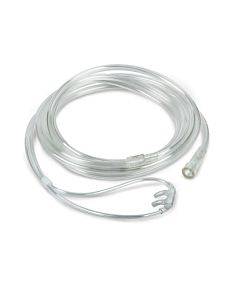Common Oxygen Tubing Complications and Solutions

Oxygen therapy is not just about oxygen reservoirs and masks. There is a range of other oxygen supplies like tubing, cannula, and connectors for effective therapy. These accessories are designed to provide patients a smooth oxygen supplementation experience. These must be maintained properly as per the product guidelines to avoid probable infection.
Oxygen tubing is designed to serve as a connection between the nasal cannula and the oxygen reservoir. It is generally made of plastic and provides steady delivery of oxygen to the patient. The tubing is wrapped around the ears of the patient like spectacles to make movement seamless.
Tubing can be reusable or disposable. Some come with added features like kink resistance to manage complications.
How to stop the oxygen tube from kinking?
Oxygen is lifesaving and it can be challenging for people who are completely dependent on supplemental oxygen. People tend to move inside their houses with extra-long tubing following them. At times, the tube tends to twirl up in spirals and occasionally form a kink. A kink is like a twist or a knot. Situations like this slow down the oxygen flow and can be dangerous.
a. An inexpensive option is to wrap a small flexible coil spring. The internal diameter of the spring must to big enough for the tube to pass through. Figure out where the kink tends to occur every time. Fix the spring with duct tape to keep it in place. If the tubing forms several kinks, make use of more than one spring. The spring keeps the tubing from kinking by enforcing a minimum bend radius. It works as a strain relief mechanism.
However, be careful as springs have sharp edges. Either you cover, turn or blunt out the edges to avoid tubing wear and tear.
b. Another inexpensive way is to web up the kinking region with a fabric. It prevents the helical twisting of the tube. Ready-made webbed tubing can be found but then it is highly-priced.
c. Anti-kink oxygen tubing is also sold in the market. It is made of a harder polymer or jacketed with a hard but flexible outer layer. The layer just acts as a structural base of the tubing.
Another safe option would be going for a thicker tube found in hospitals.
Precaution: O2 is dangerous if handled clumsily. It is an oxidizer. Whichever option you choose to avoid kinking, make sure it is safe. The materials are supposed to transfer oxygen which is reactive in nature. It must be free of hydrocarbons or oils in areas that come in contact with the oxygen.
How to deal with tangled tubing?
Oxygen tubing is available in varieties of length, few meters or several meters. The long length of the tube makes movement and daily activities easier. However, it adds more complications like a tangled line. Here are some tips to make movement easy:
a. Coiling it up when the full length is not in use, helps. Try using shorter sections for shorter trips and keep the extra in a particular place. When in need, you can pull off a few extra lengths and coil it again later. This way the extra coil does not follow you everywhere you go and remains tangle-free.
b. Having a proper coiling method is also a considerable option. It pretty much works the same way earphones do. Using a similar method not only prevents tangling but kinking as well. Any kind of tube gets accustomed to the way it is continuously coiled. So, try restraining from using different coiling or wrapping methods for your oxygen line.
It is important to have a straight oxygen line for uninterrupted supply and the best way to deal with tangled complications is to try all the options and figure what works best.


Validate your login
Sign In
Create New Account